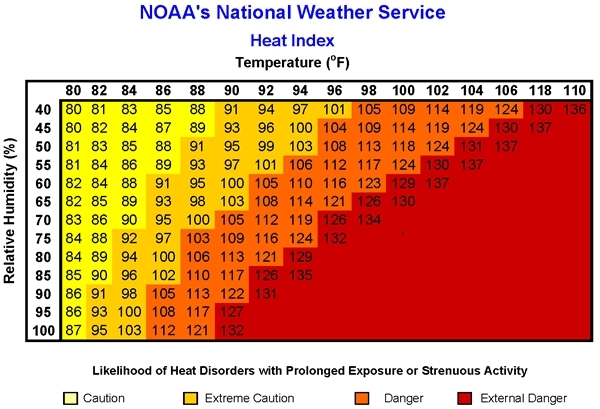Heat Index (Weather & Climate)
Heat Index
What is a Heat Index?
Know when you just can’t sweat it out
Summers in the United States can be hot, hot, hot—often characterized by heat waves that can last a week or more. East of the Rockies, these heat waves tend to combine high temperature and high humidity making it feel much hotter than it really is. On the other hand, extremely hot, dry days may actually feel cooler than they really are.
One way to describe the combined effects of temperature and humidity is using NOAA’s National Weather Service “Heat Index” (HI), sometimes referred to as the apparent temperature. The HI, given in degrees F, provides a sense of how hot it really feels when the effects of relative humidity are combined with the actual air temperature.
Knowing the heat index and taking appropriate steps when the index is high can save your life. Heat takes its toll on the body, often resulting in heat-related illnesses such as heat cramps, heat exhaustion, heat stroke and even death. In fact, heat is the number one weather-related killer in the United States, resulting in 1,500 fatalities each year. Did you know that on average, excessive heat claims more lives each year than floods, lightning, tornadoes and hurricanes combined?
|
Since HI values were devised for shady, light wind conditions, exposure to full sunshine can increase HI values by up to 15 degrees F. Strong winds, particularly with very hot, dry air, can also be extremely hazardous. The HI chart shaded zone above 105°F shows a level that may cause increasingly severe heat disorders with continued exposure and/or physical activity. Download here. (Credit: NOAA.) |
How to use the Heat Index Chart
To use the chart, find the appropriate temperature along the top row. Read down that column until you find the corresponding humidity in the far left column. The number which appears at the intersection of the temperature and humidity is the HI.
For example, if the air temperature is 96 degrees F (found on the top of the table) and the relative humidity is 65 percent (found on the left of the table), the HI — how hot it feels — is 121 degrees F.
The next time you venture outside into summer heat and humidity, be sure to check out the HI so you know when you can’t just sweat it out.
Posted August 9, 2011

